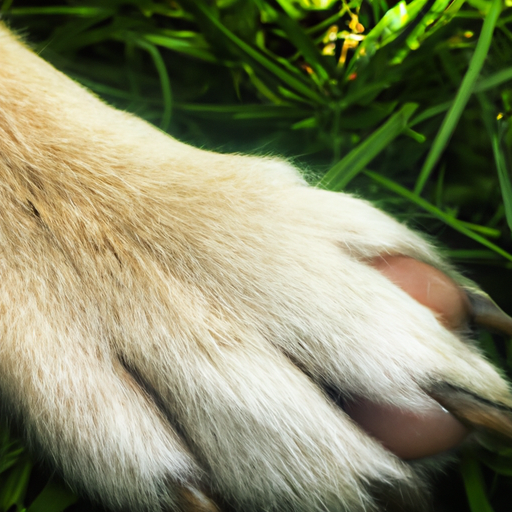1. Understanding The Structure of Dog Paws
Just like humans, your dog’s paws are complex structures that require proper care. Made up of several components, including the pads, nails, and digital pads, your dog’s feet are designed for running, jumping, and playing.
- Pads: These are the cushiony parts on the bottom of your dog’s feet. They provide traction and shock absorption.
- Nails: Dogs have nails that need trimming regularly. Long nails can cause discomfort and may lead to foot and leg problems.
- Digital Pads: These are the smaller pads located on each individual toe. They provide extra traction and stability.
2. Importance of Regular Paw Checks
Regular paw checks are essential for maintaining healthy dog paws. This allows you to identify any issues early on, such as cuts, cracks, or infections. Here are some steps you can follow:
- Inspect the Pads: Look for any signs of wear and tear, like cracks or blisters.
- Check Between the Toes: Ensure no small objects are lodged between your dog’s toes.
- Look at the Nails: They should be a reasonable length and free from cracks and splits.
3. Proper Paw Cleaning
Keeping your dog’s paws clean is crucial. Dirt and debris can lead to infections and other problems. Follow these steps for effective paw cleaning:
- Wash with warm water: This can remove dirt and debris.
- Use a gentle soap: This can help remove stubborn dirt.
- Rinse thoroughly: Ensure all soap and dirt are completely washed away.
- Dry the paws: This keeps the paws from becoming too moist, which can lead to bacterial growth.
4. Paw Protection in Different Weather Conditions
Different weather conditions can affect your dog’s paws. Here’s how to protect them in various climates:
- Hot weather: Avoid walking your dog on hot pavement. Use dog booties or apply a paw wax for protection.
- Cold weather: Ice and snow can cause frostbite. Use dog booties or apply a paw protectant.
- Wet weather: Wet paws can lead to fungal infections. Dry your dog’s paws thoroughly after each walk.
5. How to Trim Dog Nails
Regular nail trims are essential for healthy dog paws. Here’s a step-by-step guide:
- Find the right tools: Use a dog nail clipper or grinder.
- Hold your dog’s paw gently: Make sure your dog is calm and comfortable.
- Cut or grind the nail: Be careful not to cut into the quick, as this can cause bleeding.
- Reward your dog: Give your dog a treat as a reward for staying calm during the process.
6. Recognizing and Treating Common Paw Problems
Common paw problems include cuts, cracks, infections, and allergies. Here’s how to recognize and treat them:
| Problem | Signs | Treatment |
|---|---|---|
| Cuts | Redness, swelling, limping | Clean the wound, apply a bandage, see a vet if severe |
| Cracks | Rough, dry pads | Use a paw moisturizer |
| Infections | Redness, swelling, discharge | See a vet for proper medication |
| Allergies | Redness, licking, chewing | See a vet for allergy testing and treatment |
7. Importance of Regular Vet Checks
Regular vet checks are crucial for maintaining healthy dog paws. Your vet can identify any potential issues early on and provide appropriate treatment. They can also provide advice on proper paw care and nail trimming.
8. Paw Care Products
There are various paw care products on the market. These include dog booties, paw wax, paw moisturizer, and nail clippers. Each product serves a distinct purpose and can help you maintain your dog’s paw health.
Frequently Asked Questions
Q1: How often should I check my dog’s paws?
A1: Ideally, you should check your dog’s paws after each walk. This helps you identify and address any potential issues early on.
Q2: How often should I clean my dog’s paws?
A2: You should clean your dog’s paws as needed. If your dog walks on dirty or muddy ground, clean the paws immediately afterwards.
Q3: How often should I trim my dog’s nails?
A3: The frequency of nail trims depends on how fast your dog’s nails grow. On average, most dogs need their nails trimmed every 3-4 weeks.
Q4: What should I do if my dog has a paw infection?
A4: If you suspect your dog has a paw infection, visit your vet immediately. They can provide appropriate treatment to prevent the infection from getting worse.
Q5: What can I do to protect my dog’s paws in hot weather?
A5: In hot weather, avoid walking your dog on hot pavement as it can burn their paws. Use dog booties or apply a paw wax for protection.
Remember, taking care of your dog’s paws is an essential part of their overall health and wellbeing. By following these steps, you can ensure your furry friend stays happy and healthy.



